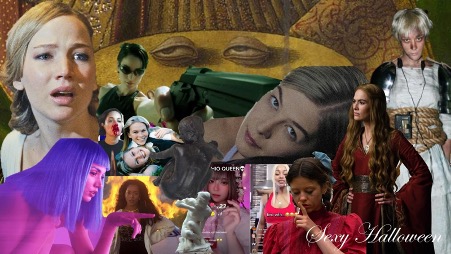Words: Tess Hardy (she/her)
Content warning: Sexual Violence
https://open.spotify.com/playlist/18EvqwRAjzlSppz5KnURZE?si=e7a02616842f489a
The post-Halloweekend scroll through TikTok or Instagram is always fun. Seeing costumes from super niche to mainstream – the aftermath of Halloween reigns supreme to the night.
But the persistence of misogyny and the male gaze has always spoilt horror films and Halloween for me. The genre seems to be a boiling point of ultra-graphic and violent misogyny under the guise of “artistic greatness” and “creative freedom”. Think Micheal Goi’s obscene and unnecessary barrel scene in Megan is Missing that adds nothing to the plot or the ending of Darren Aronofsky’s Mother! (That is too traumatic to touch on). The “boy’s club” of horror combined with the unspoken demand for sexiness and skimp on Halloween night, this year made me feel inadequate with my Trinity costume while queuing for the club next to a Victoria’s Secret Angel and a Sexy Pirate.
This combination of the fantasy of film and sexualisation is a synthesis of women and commodity: the brotherhood of capitalism and the patriarchy’s greatest desire. To reduce women to a machine, a part to be played, a costume to be worn. The thematic prevalence of the “perfect female” is a fantasy ingrained into our collective consciousness through mainstream pop culture. Many horror films position the viewer as a heterosexual male, which perpetuates reality. The genius theorist Laura Mulvey explains how ‘women exist in film to symbolise a lack,’ becoming the ‘bearer of meaning’ but never the ‘maker of meaning’. The image of the woman is thus raw material for men to look at and serves as an erotic object, both for the male characters within the film and for the spectators of the film itself.
When girls treat their boyfriend by purchasing a maid costume, NPC live streams as “The Perfect Anime Girl”, or edits of Joi from Blade Runner are all examples of this. A sexy nurse, sexy policewoman, sexy Lara Croft, or sexy princess Leia in the infamous Jabba the Hutt slave costume. These costumes all ignore the stripping, dismembering, mutilating, and disrespect shown towards the characters they emulate from film and reduce women to their idealised, primary function in the patriarchal capitalist utopia: sex. While women are entitled to dress as they please, it is naive to ignore that Halloween has been marketed to us as a night of the taboo where these ideals can briefly come to a head.
On a seemingly innocent night of fancy dress like Halloween, by breaking the fourth wall and bringing these ideals IRL, a dilemma is caused that cannot be understated. In a climate of rising misogyny and fringe gender ideals creeping into the mainstream (thanks Andrew Tate), something simple and fun like Halloween could have dire consequences. According to a study conducted for The Independent, 55% of men in the UK believed that ‘the more revealing the clothes a woman wears, the more likely it is that she will be harassed or assaulted.’ Halloween is a time that makes hiding one’s identity socially acceptable thanks to masks that obscure it, like the infamous Ghostface Mask from the 1996 film Scream. Through this “promise” of namelessness, it makes perpetrators feel uninhibited by the usual social standards of behaviour and increases the likelihood of them committing a crime.
However, hope is not completely lost in the sea of fetishisation and violence. When scrolling through my feed this Halloween, I saw an increase of deranged females being emulated and the reaction they provoked in the comments of unapproving teenage boys gave a brilliant insight into the view of femininity in the 21st century. I found this correlated with the rise in the “female rage” and “good for her” sub-genres of horror films. I’m sure your FYP is flooded with the deafening screaming edits of Cersei Lannister and Taraji P. Henson in Hidden Figures’ “working like a dog!” scene, backed with Mitski or Lana Del Rey.
On Halloween, you can enter the hall of enraged, destructive women next to all-stars Jennifer Check, Nancy Downs, and Red. The choice of a costume is evolving from “dressing up” to being a radical act of resistance. Even by being an “anti-cool girl”, going silly by being Georgia as an Olive in Angus, Thongs and Perfect Snogging, or Wallace from Wallace and Gromit, complete with bald cap and cheese. Ranging from Chloë Sevigny’s iconic depiction of Joan of Arc with her Walkman, or feminist pagan poster girl Circe from the Odyssey, to a psycho ex-girlfriend like Lillith or Amy Dune. The multifarious aura surrounding feminine figures in film, literature and culture – whether fierce, striking, innovative or straight-up hell-bent – can emerge at Halloween and stay with you into the following months, and then years…

